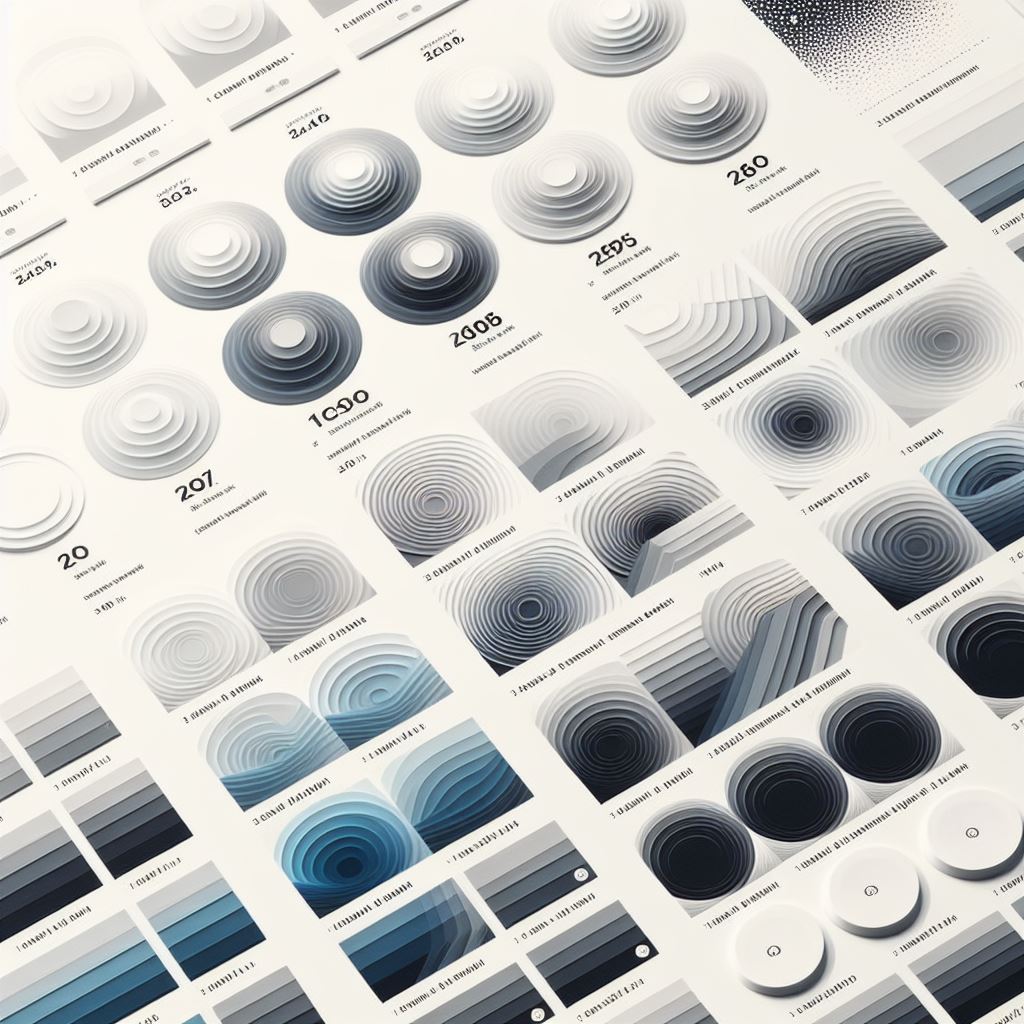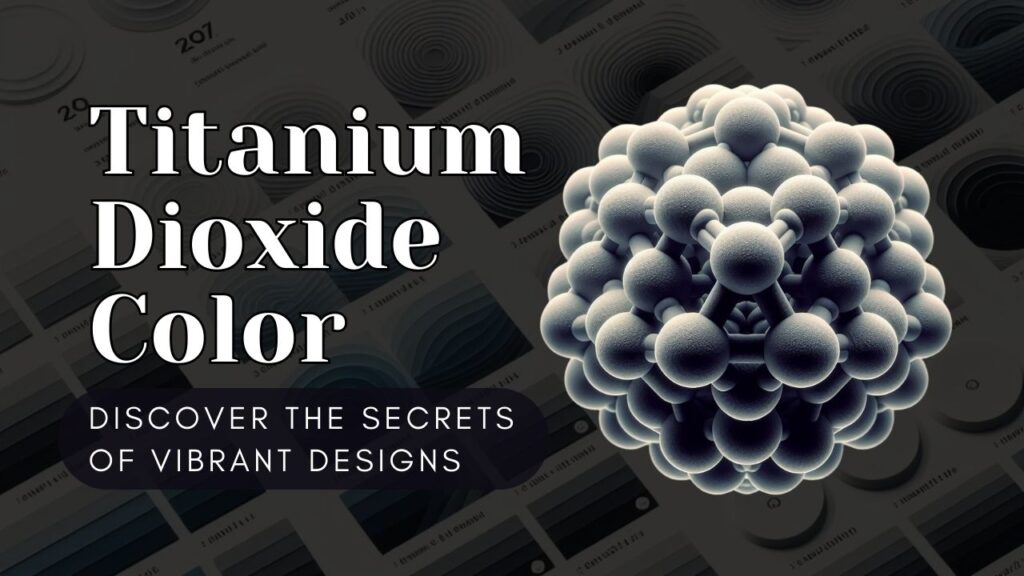Titanium dioxide color is widely used in various industries for its vibrant and long-lasting properties. This article explores the science behind titanium dioxide color, its applications in different industries, its environmental impact, and the latest innovations in its manufacturing. Here are the key takeaways from this article:
The Science Behind Titanium Dioxide Color
Understanding the Properties of Titanium Dioxide
Titanium Dioxide is a versatile and widely used pigment in various industries. It is known for its exceptional whiteness, opacity, and brightness. These properties make it an ideal choice for achieving vibrant and vivid colors in different applications.
One of the key characteristics of Titanium Dioxide is its ability to scatter and reflect light. This property allows it to enhance the color vibrancy of other pigments when used in formulations. By reflecting and scattering light, Titanium Dioxide helps to create a more intense and eye-catching color effect.
In addition to its color-enhancing properties, Titanium Dioxide also offers excellent coverage. It can effectively hide imperfections and provide a smooth and even surface. This makes it highly desirable in industries where a flawless finish is essential, such as cosmetics, food, and textiles.
To summarize, Titanium Dioxide possesses remarkable properties like whiteness, opacity, brightness, light scattering, and coverage. These properties are crucial in achieving vibrant and visually appealing colors in various applications.
How Titanium Dioxide Enhances Color Vibrancy

Titanium dioxide is a versatile pigment that plays a crucial role in enhancing color vibrancy in various applications. Its unique properties make it an ideal choice for achieving vibrant and long-lasting colors.
One of the key ways titanium dioxide enhances color vibrancy is through its high refractive index. This means that it has the ability to scatter and reflect light, resulting in brighter and more intense colors. When used in pigments, titanium dioxide can significantly enhance color saturation and depth, creating visually striking designs.
In addition to its refractive properties, titanium dioxide also acts as an opacifying agent. It can block and scatter light, which helps to improve the coverage and opacity of colored materials. This ensures that the true color of the pigment is fully expressed, even in thin layers or when applied on different surfaces.
To summarize, titanium dioxide enhances color vibrancy by scattering and reflecting light, increasing color saturation, and improving coverage and opacity. Its unique properties make it an essential ingredient in achieving vibrant and visually appealing designs.
The Role of Titanium Dioxide in Pigment Formulation
Titanium dioxide plays a crucial role in pigment formulation, especially in the field of photocatalysis. Photocatalysis is a process that utilizes light energy to initiate chemical reactions. Titanium dioxide is an excellent photocatalyst due to its unique properties. It has a wide bandgap, allowing it to absorb a broad range of light wavelengths, including ultraviolet (UV) light. This property enables titanium dioxide to generate reactive oxygen species when exposed to light, which can effectively degrade organic pollutants.
In addition to its photocatalytic properties, titanium dioxide also acts as a white pigment in many applications. Its high refractive index and light-scattering ability contribute to the vibrant and opaque appearance of various products. Titanium dioxide is commonly used in paints, coatings, plastics, and cosmetics to enhance color intensity and opacity.
When formulating pigments, titanium dioxide’s particle size and surface treatment are crucial factors. Controlling these parameters allows manufacturers to achieve desired color properties and improve the dispersibility of the pigment in different mediums.
To summarize, titanium dioxide’s role in pigment formulation extends beyond color enhancement. Its photocatalytic properties make it a valuable component in environmental remediation, while its white pigment characteristics contribute to the visual appeal of numerous products.
Applications of Titanium Dioxide Color
Titanium Dioxide in the Cosmetics Industry
Titanium Dioxide is a key ingredient in many cosmetic products, providing UV protection and enhancing the brightness of colors. Its light-scattering properties make it ideal for achieving a smooth and even skin tone.
- Titanium Dioxide is commonly used in sunscreens, foundations, and powders.
- It helps to protect the skin from harmful UV rays, making it a crucial component in sun protection products.
Tip: When selecting cosmetic products, look for those containing Titanium Dioxide for effective UV protection and color enhancement.
Titanium Dioxide in the Food and Beverage Industry

Titanium dioxide is widely used in the food and beverage industry for its unique properties and versatility. It is commonly used as a food additive, providing a white color and enhancing the appearance of various products. Food products such as candies, chewing gum, and icing often contain titanium dioxide to achieve a bright and appealing color.
In addition to its visual appeal, titanium dioxide also serves as a UV absorber in food and beverage products. This property helps protect sensitive ingredients from degradation caused by exposure to sunlight. It is commonly used in dairy products, beverages, and sauces to extend their shelf life.
When using titanium dioxide in the food and beverage industry, it is important to consider the regulations and guidelines set by regulatory bodies. These guidelines ensure the safe use of titanium dioxide and set limits on its concentration in food products.
Tips for using titanium dioxide in the food and beverage industry:
- Always follow the recommended dosage and usage guidelines provided by the manufacturer.
- Store titanium dioxide in a cool, dry place away from direct sunlight.
- Conduct regular quality checks to ensure the purity and safety of the titanium dioxide used.
By understanding the properties and regulations surrounding titanium dioxide, the food and beverage industry can continue to utilize this versatile ingredient to create visually appealing and safe products.
Titanium Dioxide in the Textile Industry
Titanium dioxide is widely used in the textile industry due to its unique properties and versatility. Whiteness is an important characteristic in textiles, and titanium dioxide is known for its exceptional whitening capabilities. It can be used as a pigment to achieve bright and vibrant colors in fabrics.
In addition to its color-enhancing properties, titanium dioxide also offers UV protection. This is particularly beneficial in textiles that are exposed to sunlight, as it helps to prevent fading and degradation caused by UV rays.
In textile manufacturing, titanium dioxide can be incorporated into the fabric through various methods, such as dyeing or coating. It can be applied to both natural and synthetic fibers, making it suitable for a wide range of textile products.
Benefits of using titanium dioxide in the textile industry:
- Enhanced color vibrancy
- Improved UV protection
- Increased durability
- Versatile application methods
Tip: When using titanium dioxide in textile production, it is important to consider the environmental impact. Look for sustainable alternatives and follow regulations and guidelines to minimize any negative effects.
Environmental Impact of Titanium Dioxide Color
The Effects of Titanium Dioxide on the Environment
Titanium dioxide has been widely used in various industries due to its unique properties and vibrant color enhancement capabilities. However, its extensive use has raised concerns about its potential environmental impact. Studies have shown that titanium dioxide nanoparticles, which are commonly used in products, can accumulate in the environment and pose risks to aquatic organisms and ecosystems.
One of the main concerns is the photocatalytic activity of titanium dioxide, which can lead to the production of reactive oxygen species when exposed to sunlight. These reactive oxygen species can contribute to air pollution and have detrimental effects on human health.
To address these environmental concerns, researchers and manufacturers are exploring sustainable alternatives to titanium dioxide. Some of these alternatives include natural pigments derived from plants and minerals, as well as biodegradable polymers that can provide similar color enhancement properties.
It is important for industries to adhere to regulations and guidelines for the usage of titanium dioxide to minimize its environmental impact. These regulations often include limits on the concentration of titanium dioxide nanoparticles in products and guidelines for proper disposal and waste management.
- In summary, while titanium dioxide color offers vibrant designs, its environmental impact should be carefully considered. Researchers and industry professionals are actively working towards finding sustainable alternatives and implementing responsible practices to mitigate any potential harm.
Sustainable Alternatives to Titanium Dioxide
While titanium dioxide is widely used for its vibrant color properties, there are also sustainable alternatives available that can be used in various industries. These alternatives offer similar color performance while reducing the environmental impact.
One such alternative is mica, a naturally occurring mineral that can be used as a pigment. Mica provides a wide range of colors and has a shimmering effect, making it a popular choice in cosmetics and personal care products.
Another sustainable alternative is iron oxide, which is derived from iron ore. Iron oxide pigments offer excellent color stability and are commonly used in paints, coatings, and plastics.
In addition to mica and iron oxide, natural dyes extracted from plants, fruits, and vegetables are gaining popularity as sustainable alternatives to titanium dioxide. These natural dyes provide unique and vibrant colors, and they are often used in the food and textile industries.
It is important for industries to explore and adopt these sustainable alternatives to titanium dioxide to minimize the environmental impact and promote a more eco-friendly approach to color formulation.
Regulations and Guidelines for Titanium Dioxide Usage
When it comes to the usage of titanium dioxide, there are several regulations and guidelines in place to ensure its safe and responsible use. These regulations aim to protect both human health and the environment. Here are some key points to consider:
- European Union (EU) Regulation: The EU has implemented strict regulations regarding the use of titanium dioxide in consumer products. The European Chemicals Agency (ECHA) has classified titanium dioxide as a Category 2 carcinogen when inhaled in powder form. As a result, products containing titanium dioxide must be labeled with appropriate warnings.
- United States (US) Regulations: In the US, the Food and Drug Administration (FDA) regulates the use of titanium dioxide in food and cosmetics. The FDA has determined titanium dioxide to be safe for use in these applications, as long as it meets certain purity requirements.
Tip: It is important to stay updated with the latest regulations and guidelines to ensure compliance and safety.
- International Standards: Various international organizations, such as the International Organization for Standardization (ISO), have developed standards for the use of titanium dioxide. These standards cover aspects such as purity, particle size, and labeling requirements.
- Industry Best Practices: In addition to regulations, industry best practices play a crucial role in ensuring the safe and responsible use of titanium dioxide. This includes proper handling, storage, and disposal of titanium dioxide-containing products.
It is essential for manufacturers, consumers, and regulatory bodies to work together to ensure the responsible use of titanium dioxide and minimize any potential risks.
Innovations in Titanium Dioxide Color
Nanostructured Titanium Dioxide for Enhanced Color Performance
Nanostructured titanium dioxide (TiO2) is a cutting-edge innovation in the field of color performance. By manipulating the structure of titanium dioxide at the nanoscale, researchers have been able to unlock new possibilities for vibrant and long-lasting colors.
One of the key advantages of nanostructured TiO2 is its increased surface area, which allows for better light absorption and reflection. This results in colors that appear more intense and vibrant to the human eye.
In addition to enhanced color performance, nanostructured TiO2 also offers improved durability. The nanoscale structure provides a protective barrier, making the color less prone to fading or degradation over time.
Benefits of Nanostructured Titanium Dioxide:
- Increased color intensity
- Improved color durability
- Enhanced light absorption and reflection
Tip: When using nanostructured TiO2, it is important to consider the appropriate concentration and formulation to achieve the desired color effect.
Titanium Dioxide Coatings for Long-lasting Color
Titanium dioxide coatings are widely used in various industries to achieve long-lasting color effects. These coatings provide a protective layer that enhances the durability and resistance of the colored surface. By applying titanium dioxide coatings, the color can withstand harsh environmental conditions, such as UV radiation and moisture, without fading or deteriorating.
One of the key advantages of titanium dioxide coatings is their ability to maintain color vibrancy over an extended period of time. The high refractive index of titanium dioxide particles allows them to efficiently scatter and reflect light, resulting in intense and vibrant colors. This property is particularly beneficial in applications where long-lasting color is desired, such as automotive coatings, architectural paints, and consumer electronics.
To ensure the effectiveness of titanium dioxide coatings, it is important to consider the proper formulation and application techniques. The thickness and uniformity of the coating layer, as well as the choice of binders and additives, can significantly impact color performance and longevity. Manufacturers and researchers are constantly exploring new formulations and techniques to optimize the durability and appearance of titanium dioxide coatings.
In addition to their color-enhancing properties, titanium dioxide coatings also offer additional benefits. They can improve the scratch resistance and hardness of the coated surface, providing protection against wear and tear. Furthermore, titanium dioxide coatings can contribute to the self-cleaning properties of certain materials, as they have photocatalytic properties that help break down organic contaminants when exposed to light.
Overall, titanium dioxide coatings play a crucial role in achieving long-lasting and vibrant colors in various industries. Their unique properties and versatility make them a preferred choice for applications where color durability and performance are paramount.
Advancements in Titanium Dioxide Manufacturing Processes

In recent years, there have been significant advancements in the manufacturing processes of titanium dioxide. These advancements have led to improved efficiency, cost-effectiveness, and environmental sustainability in the production of titanium dioxide.
One of the key advancements is the development of new catalysts that enhance the reaction rate and yield of titanium dioxide synthesis. These catalysts allow for faster and more efficient production, reducing the overall manufacturing time and energy consumption.
Another important development is the implementation of continuous flow reactors. Unlike traditional batch reactors, continuous flow reactors enable a continuous and controlled production process, resulting in higher product quality and consistency.
Additionally, nanotechnology has played a significant role in advancing titanium dioxide manufacturing. The use of nanoscale materials and techniques allows for precise control over particle size, shape, and distribution, resulting in improved color performance and stability.
To summarize, the advancements in titanium dioxide manufacturing processes have revolutionized the industry by improving efficiency, quality, and sustainability. These developments have paved the way for the production of high-quality titanium dioxide with enhanced color properties.
Innovations in Titanium Dioxide Color have revolutionized the manufacturing industry. Titanium Dioxide Color is widely used in various applications, including paints, coatings, plastics, and cosmetics. Its exceptional opacity, brightness, and UV resistance make it a popular choice for achieving vibrant and long-lasting colors. At Home – Safe Climber Overseas Pvt. Ltd., we specialize in the supply of PVC Resin, including high-quality Titanium Dioxide Color. Our extensive range of PVC Resin products caters to the diverse needs of our customers. Whether you are in the paint industry or the plastic manufacturing sector, our top-notch Titanium Dioxide Color will enhance the quality and performance of your products. Visit our website now to explore our wide range of PVC Resin products and place your order today!
Conclusion
In conclusion, titanium dioxide color is a versatile and powerful tool for creating vibrant designs. Its ability to reflect and scatter light makes it ideal for a wide range of applications, from cosmetics to paints and coatings. By understanding the secrets of titanium dioxide color, designers can unlock endless possibilities for creating visually stunning and impactful designs. Whether it’s adding a pop of color to a product or creating a bold statement, titanium dioxide color is a must-have in every designer’s toolkit. So, embrace the power of titanium dioxide color and let your creativity shine!
Frequently Asked Questions
What is titanium dioxide color?
Titanium dioxide color is a pigment that is commonly used to enhance the vibrancy and brightness of colors in various industries such as cosmetics, food and beverage, and textiles.
How does titanium dioxide enhance color vibrancy?
Titanium dioxide has excellent light-scattering properties, which allows it to reflect and scatter light, thereby enhancing the intensity and brightness of colors.
Is titanium dioxide color safe for use in cosmetics?
Yes, titanium dioxide color is considered safe for use in cosmetics. It is widely used in products such as foundations, powders, and lipsticks.
What are the sustainable alternatives to titanium dioxide color?
Some sustainable alternatives to titanium dioxide color include natural pigments derived from plants, minerals, and other organic sources.
Are there any regulations or guidelines for titanium dioxide usage?
Yes, there are regulations and guidelines for the usage of titanium dioxide in various industries. These regulations ensure the safe and responsible use of the pigment.
What are some innovations in titanium dioxide color?
Some innovations in titanium dioxide color include the development of nanostructured titanium dioxide for enhanced color performance and the use of titanium dioxide coatings for long-lasting color.






